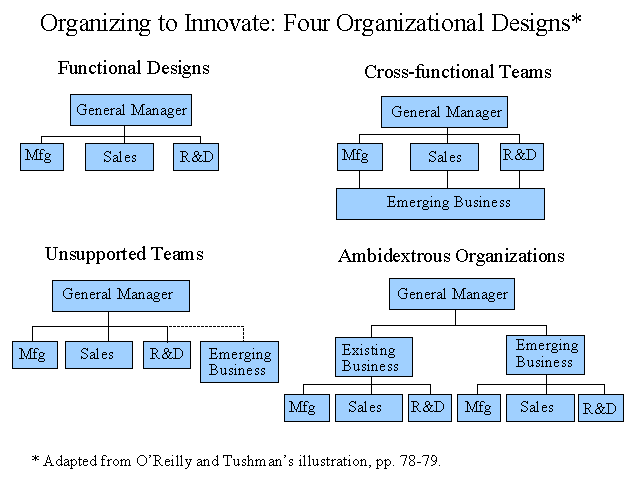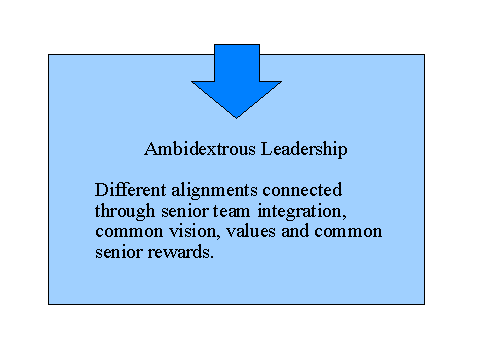
Summary by Lee Salemi
Master of Accountancy Program
University of South Florida, Fall 2004
Strategy Main Page |
Structure/Restructure Main Page
In this article, O’Reilly and Tushman examine what happens when contemporary businesses try to expand outside of their existing market and products. The authors discovered that the successful companies are those that separate new exploratory units from exploitive traditional units, but still keep a tightly linked executive team to manage the organizational separation. This type of company is referred to as an “ambidextrous organization”.
Managers are expected to be able to explore new opportunities while also making steady improvements to what already exists. Most companies are successful making steady improvements, but cannot succeed at innovation at the same time. The authors utilize Kodak as an example. Kodak has been successful with traditional photography, but has not been able to compete strongly in the digital camera market.
Exploiting and Exploring
Maintaining several types of innovation is necessary for an organization to compete. The authors identified the following types of innovation:
Incremental innovations involve small improvements to an existing product or process to enhance efficiency.
Architectural innovations involve incorporating new technology and processes to change business elements.
Discontinuous innovations occur when an advance is so powerful, it makes old products or processes obsolete.
The table below illustrates what the authors refer to as “A Map of Innovation”. The type of innovation as well as the target market can be plotted on this matrix. Companies that pursue modest incremental innovations would be plotted on the lower left while breakthrough innovations would be plotted in the upper right area of the matrix.
| A Map of Innovation | |||
| Incremental Innovations |
Architectural Innovations |
Discontinuous Innovations |
|
| New Customers | |||
| Existing Customers | |||
The authors studied various companies’ approaches to innovation through this matrix and found that breakthroughs were structured in one of four ways. Innovation breakthroughs can be integrated into existing functional designs and management structure. They can also be set up as cross-functional teams operating from within the existing organization, but outside of the organization’s management structure. Breakthroughs structured through unsupported teams come from outside the established organization and the company’s management hierarchy. The final breakthrough structure is the aforementioned ambidextrous organization. Under this structure, the breakthrough is set up as an independent unit with its own culture, processes, and structure, but the unit is still integrated within the existing management hierarchy.

By comparing the different breakthrough structures, the authors found the ambidextrous organization to be far superior with regards to innovations (90% of goals were reached) as well as the success of the existing business. The structure of an ambidextrous organization allows the organization to share information and processes when needed while still maintaining separate units. Managerial coordination allows resources to be shared, but the organizational separation ensures that the new unit will not become just another part of the company.
The authors use two organizations, USA Today and Ciba Vision, as examples of how companies can renew themselves with breakthrough products without harming its existing business. Both companies were struggling to compete in their respective markets until they became ambidextrous organizations. The following are a few managerial and organizational characteristics of ambidextrous organizations such as USA Today and Ciba Vision (in addition, see Exhibit 3 below):
Senior managers must agree with and be committed to the network strategy involved in an ambidextrous organization. Project leaders must be willing to challenge the status quo.
Senior leadership of different units must be tightly integrated and should keep each other informed of necessary information.
Executive incentive programs involving the entire company are used as opposed to bonus programs tied to individual units.
The company’s research and development budget may be allotted almost entirely to producing breakthroughs while existing business pursues only incremental innovations.
A clear vision is crucial in transforming a company into an ambidextrous organization.
| The Scope of the Ambidextrous Organization | ||
| Alignment of: | Exploitative Business | Exploratory Business |
| Strategic intent | Cost, profit | Innovation, growth |
| Critical tasks | Operations, efficiency, incremental innovation |
Adaptability, new products, breakthrough innovation |
| Competencies | Operational | Entrepreneurial |
| Structure | Formal, mechanistic | Adaptive, loose |
| Controls, rewards | Margins, productivity | Milestones, growth |
| Culture | Efficiency, low risk, quality, customers |
Risk taking, speed, flexibility, experimentation |
| Leadership role | Authoritative, top down | Visionary, involved |

____________________________________________
Related summaries:
Christensen, C. M. 1997. Making strategy: Learning by doing. Harvard Business Review (November-December): 141-142, 144, 146, 148, 150-154, 156. (Summary).
Clinton, B. D. and A. H. Graves. 1999. Product value analysis: Strategic analysis over the entire product life cycle. Journal of Cost Management (May/June): 22-29. (Summary).
De Geus, A. 1999. The living company. Harvard Business Review (March-April): 51-59. (Summary).
Fonvielle, W. and L. P. Carr. 2001. Gaining strategic alignment: Making scorecards work. Management Accounting Quarterly (Fall): 4-14. (Summary).
Gosselin, M. 1997. The effect of strategy and organizational structure on the adoption and implementation of activity-based costing. Accounting, Organizations and Society 22(2): 105-122. (Summary).
Iansiti, M. and R. Levien. 2004. Strategy as ecology. Harvard Business Review (March): 68-78. (Summary).
Kaplan, R. S. and D. P. Norton. 1996. Using the balanced scorecard as a strategic management system. Harvard Business Review (January-February): 75-85. (Summary).
Kim, W. C. and R. Mauborgne. 1997. Value innovation: The strategic logic of high growth. Harvard Business Review (January-February): 103-112. (Summary).
Kim, W. C. and R. Mauborgne. 1999. Creating new market space: A systematic approach to value innovation can help companies break free from the competitive pack. Harvard Business Review (January-February): 83-93. (Summary).
Kim, W. C. and R. Mauborgne. 2002. Charting your company's future. Harvard Business Review (June): 77-83. (Summary).
Langfield-Smith, K. 1997. Management control systems and strategy: A critical review. Accounting, Organizations and Society 22(2): 207-232. (Summary).
Luehrman, T. A. 1998. Strategy as a portfolio of real options. Harvard Business Review (September-October): 89-99. (Summary).
O'Clock, P. and K. Devine. 2003. The role of strategy and culture in the performance evaluation of international strategic business units. Management Accounting Quarterly (Winter): 18-26. (Summary).
Paladino, B. 2007. 5 key principles of corporate performance management: How do Balanced Scorecard Hall of Fame, Malcolm Baldrige, Sterling, Fortune 100, APQC, and Forbes award winners drive value? Strategic Finance (June): 39-45. (Note).
Porter, M. E. 1980. Competitive Strategy: Techniques for Analyzing Industries and Competitors. The Free Press. (Summary).
Porter, M. E. 1996. What is a strategy? Harvard Business Review (November-December): 61-78. (Summary).
Porter, M. E. 2001. Strategy and the internet. Harvard Business Review (March): 63-78. (Summary).
Reeves, M., C. Love and P. Tillmanns. 2012. Your strategy needs a strategy. Harvard Business Review (September): 76-83. (Note).